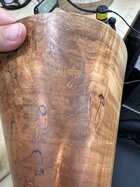Hello,
I am hoping that someone has some advice on how I can fix the finish on a piece. I am really hoping to bring it to the symposium. I turned this piece from one of my dad's rough turned bowls. I think that it has been drying since 1995 (so it was dry). Assuming maple. I sanded to 1200 and applied Osmo oil. The oil did not penetrate evenly and there are what look like tear out along the end grain that follows the growth rings. I have not had this happen on a piece before. I did try to repair but taking off the first coat of Osmo, applying a hardner, resanding and reapplying the Osmo. Same thing.
Two questions -
- Can anyone tell me why this happened? My only guess is that it was from sanding - I am using an orbital sander with 3" disks up to 400 and then hand sanding 600, 800, 1200. I do turn the lathe speed way down when sanding but maybe not enough??? If that is it the most likely cause, how do I prevent in the future?
- I have Liberon black bison wax and was thinking of applying it over the Osmo. I am hoping that this might even out the finish and "hide" those spots. I have not used wax before so not sure if it would work. I would be buffing by hand and do NOT want a high gloss.
Thank you!!!!!!
Cheers,
Alex
I am hoping that someone has some advice on how I can fix the finish on a piece. I am really hoping to bring it to the symposium. I turned this piece from one of my dad's rough turned bowls. I think that it has been drying since 1995 (so it was dry). Assuming maple. I sanded to 1200 and applied Osmo oil. The oil did not penetrate evenly and there are what look like tear out along the end grain that follows the growth rings. I have not had this happen on a piece before. I did try to repair but taking off the first coat of Osmo, applying a hardner, resanding and reapplying the Osmo. Same thing.
Two questions -
- Can anyone tell me why this happened? My only guess is that it was from sanding - I am using an orbital sander with 3" disks up to 400 and then hand sanding 600, 800, 1200. I do turn the lathe speed way down when sanding but maybe not enough??? If that is it the most likely cause, how do I prevent in the future?
- I have Liberon black bison wax and was thinking of applying it over the Osmo. I am hoping that this might even out the finish and "hide" those spots. I have not used wax before so not sure if it would work. I would be buffing by hand and do NOT want a high gloss.
Thank you!!!!!!
Cheers,
Alex

